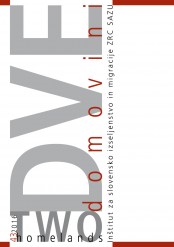Factors of Social Integration of Immigrants in Spain: The Example of the City of Jerez de la Frontera
DOI:
https://doi.org/10.3986/dd.2016.1.11Keywords:
Spanish immigration legislation, immigrant integration, motives for migration, Jerez de la Frontera, in-depth interviewsAbstract
Spain has always been part of international migration flows. Either through emigration or immigration, many Spaniards have found their home abroad and Spain has become one for many people from all around the world. This paper, however, focuses on the latter. It investigates Spanish immigration legislation and integration, focusing on the factors of social inclusion of immigrants and their integration into Spanish society. The core of the paper presents the results of an analysis of ten in-depth interviews with immigrants of various cultural and ethnic backgrounds, all residing in Jerez de la Frontera. In addition, the results of three interviews with professionals who work with immigrants are analyzed. Immigrants usually come prepared, already knowing people in Spain who support them financially, guide them through the bureaucracy process and help them with integration and finding work.
Downloads
References
Aparicio, Rosa, Portes, Alejandro (2014). Crecer en España. La integración de los hijos de inmigrantes. Barcelona: Obra Social ”la Caixa”.
Arango, Joaquín (2013). Exceptional in Europe? Spain`s Experience with Immigration and Integration, http:// www.migrationpolicy.org/research/exceptional-europe-spains-experience-immigration-and-integration (20. 1. 2014).
BOE (2014). Boletín Oficial del Estado – Ley Orgánica 4/2000, de 11 de enero, sobre derechos y libertades de los extranjeros en España y su integración social, http://www.boe.es/buscar/pdf/2000/ BOE-A-2000-544-consolidado.pdf (26. 2. 2015).
Clayton, M. Pamela (2007). Introduction. Migrants and Refugees in Europe: Models of Integration and New Challenges for Vocational Guidance (ed. Silvana Greco, Pamela M. Clayton, Alenka Janko Spreizer). Milano: Franco Angeli, 10.
Cukut Krilić, Sanja (2013). Obravnava staranja v migracijskih študijah in socialni gerontologiji. Dve domovini / Two Homelands 38, 99–113.
De Palo, Domenico, Faini, Ricardo, Venturini, Alessandra (2006). The Social Assimilation of Immigrants, http://ftp.iza.org/dp2439.pdf (3. 9. 2015).
Enríquez Gonzáles, Carmen (2014). The price of Spanish and European citizenship, http://www.realinstitutoelcano.org/wps/wcm/connect/a175338042cc32dd8b5cff21e143ff92/ARI4-2014_Gonzalez_Enriquez_price_spanish_and_european_citizenship.pdf?MOD=AJPERES&CACHEID=a175338042cc32dd8b5cff21e143ff92 (2. 3. 2015).
Estudio de la Población extranjera empadronada en Jerez de la Frontera (2014). Jerez de la Frontera: Ayuntamiento de Jerez de la Frontera, Delegación de Bienestar Social, Igualdad y Salud, Departamento de Inclusión Social e Inmigración.
Ferrand Rodriguez, Graciela (2013). Citizenship Pathways and Border Protection: Spain, http://www.loc. gov/law/help/citizenship-pathways/spain.php (25. 2. 2015).
García Castaño, Francisco Javier, Rubio Gómez, María, Bouachra, Ouafaa (2015). Immigrant Students at School in Spain: Constructing a Subject of Study. Dve domovini / Two Homelands 41, 35–47.
Guimarães Pereira, Ângela, Pedrosa, Tiago, Simon, Karl-Heinz, Matovelle, Alexa (2015). In-depth interviews, http://www.ivm.vu.nl/en/Images/PT8_tcm53-161513.pdf (12. 3. 2015).
Hunsicker, A. (2011). Behind the Shield: Anti-Riot Operations Guide. Boca Raton, Florida: Universal Publishers.
INE (2014). Instituto Nacional de Estadística - Press Release. Population Figures at 1 January 2014, Migration Statistics 2013, http://www.ine.es/en/prensa/np854_en.pdf (19. 1. 2015).
IOM (2014). International Organization for Migration – Spain, http://www.iom.int/cms/en/sites/iom/ home/where-we-work/europa/european-economic-area/spain.html (10. 3. 2015).
Jiménez, J. Tomás (2011). Immigrants in the United States: How Well Are They Integrating into Society? Migration Policy Institute and the European University Institute, http://www.migrationpolicy.org/research/immigrants-united-states-how-well-are-they-integrating-society (29. 8. 2015).
Knežević Hočevar, Duška, Cukut, Sanja, Černič Istenič, Majda (2009). Intercultural dialogue between lip service and practice. Dve domovini / Two Homelands 30, 29–49.
Medica, Karmen (2010). Sodobni integracijski procesi in kontroverznosti krožnih migracij. Migranti v Sloveniji – med integracijo in alienacijo (ur. Karmen Medica, Goran Lukič in Milan Bufon). Koper: Univerza na Primorskem, Znanstveno-raziskovalno središče, Univerzitetna založba Annales, Zgodovinsko društvo za južno Primorsko, 37–57.
MIPEX (2015). Migrant Integration Policy Index, Play with Data, http://www.mipex.eu/play/ (26. 8. 2015).
MIPEX (2015). Migrant Integration Policy Index, Play with Data, http://www.mipex.eu/play/ (26. 8. 2015). Niessen, Jan, Huddleston, Thomas, Citron, Laura (2007). Migrant Integration Policy Index, http://www. mipex.eu/sites/default/files/downloads/migrant_integration_policy_index_mipex_ii-2007.pdf (26. 8. 2015).
OECD (2015). OECD-International Migration Database. Database on Immigrants in OECD Countries (DIOC). OECD`s iLibrary, http://stats.oecd.org/Index.aspx?DataSetCode =MIG# (19. 1. 2015).
OECD/European Union (2015). Indicators of Immigrant Integration 2015: Settling In. OECD Publishing Paris, http://www.oecd-ilibrary.org/social-issues-migration-health/indicators-of-immigrant-integration-2015-settling-in_9789264234024-en (1. 9. 2015).
O`Reilly, Karen (2012). International Migration and Social Theory. New York: Palgrave Macmillan.
Pajnik, Mojca (2014). Multikulturalizem pro et contra: kritika liberalne perspektive in populistično-demagoške denunciacije. Dve domovini / Two Homelands 39, 19–30.
Pérez Ortega, Nieves (2003). Spain: Forging an Immigration Policy, http://www.migrationpolicy.org/article/spain-forging-immigration-policy (20. 1. 2015).
Poros, Maritsa (2011). Migrant Social Networks: Vehicles for Migration, Integration, and Development, http://www.migrationpolicy.org/article/migrant-social-networks-vehicles-migration-integration-and-development (2. 9. 2015).
Repič, Jaka (2008). Prostori soočanja ali izključevanja? Migracijski procesi, neenakost in multikulturalizem v Španiji. Prostori soočanja in srečevanja: spominski zbornik za Boruta Brumna (ed. Rajko Muršič and Katja Hrobat). Ljubljana: Znanstvena založba Filozofske fakultete, 69–83.
Rodríguez Pardo, Estrella (2010). Una apuesta por la integración. Revista del Ministerio de Trabajo e Inmigración, Migraciones Internacionales (ed. Lorenzo Cachón Rodríguez and César Mogo Zaro). Madrid: Ministerio de Trabajo e Inmigración, 19–31.
Rodríguez Pardo, Estrella (2010). Una apuesta por la integración. Revista del Ministerio de Trabajo e Inmigración, Migraciones Internacionales (ed. Lorenzo Cachón Rodríguez and César Mogo Zaro). Madrid: Ministerio de Trabajo e Inmigración, 19–31.
The Economist (2000). The message of El Ejido. The Economist digital edition, http://www.economist. com/node/329675 (25. 8. 2015).
Vonk, W. Olivier (2012). Dual nationality in the European Union: a study on changing norms in public and private international law and in the municipal laws of four EU member states. Leiden, Boston: M. Nijhoff.
Downloads
Published
How to Cite
Issue
Section
License

This work is licensed under a Creative Commons Attribution-NonCommercial-NoDerivatives 4.0 International License.
Authors guarantee that the work is their own original creation and does not infringe any statutory or common-law copyright or any proprietary right of any third party. In case of claims by third parties, authors commit their self to defend the interests of the publisher, and shall cover any potential costs.
More in: Submission chapter





